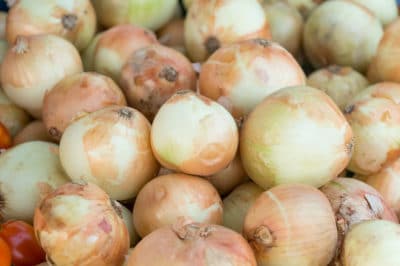Types of Sweet Onions
Most sweet onions are short-day onions. The bulbs of these onions grow in cool conditions with days that are 10 to 12 hours long. The larger the leaves on short-day onions grow, the sweeter and larger the bulbs will be. Most sweet onions grow in the southern states near 32° north latitude. The onions are planted in the fall and grow through the winter to reach their largest size for a springtime harvest.
If you live in a northern climate, you can plant intermediate-day onions for fall planting. As long as the temperature doesn’t reach 0°F (-17 C), you can plant these in USDA zone 7 for sweet onions.
Sweet Onion Varieties
Certain onion varieties are sweeter than others, but they still need low levels of sulfur in the soil for a mild, smooth flavor. The following varieties are the most popular sweet onion varieties:
- Granex – These are the sweetest variety of sweet onions. The original hybrid Granex was a cross between the Grano onion and the Bermuda onion. It is also known as the Vidalia onion, Noonday onion or the Maui Sweet onion. The name depends on where the onion is grown. These are short-day onions.
- Walla Wall Sweet – This is an intermediate-day onion, which is sweet and tolerant to the cold, making it a good choice for cool climates. Other sweet onions include Stockton Red, Candy and Italian Red Torpedo, although these are not as sweet as Vidalia.
Growing Sweet Onions
Whether you’re growing short-day onions in the south or intermediate-day onions in the north, plant them in late summer or early fall. Transplants are the easiest for planting, but you can also use seeds, as long as you sow them eight weeks before planting time. No matter if you use seeds or transplants, preparing the soil is essential before planting. Use the following tips for preparing you soil and planting your seeds or transplants:
- Turn over a garden bed that has well-drained, fertile soil and rake out any stones and weeds.
- Work 2 inches of compost into the soil or raised bed before your fall planting.
- Apply organic fertilizer to the soil because onions feed heavily. You won’t have to fertilize them again, until the bulbs start growing in the spring.
- For seed planting, just sprinkle them on top of the soil.
- Spread about one-quarter inch of sand or vermiculite over the seeds.
- Moisten the seed bed.
- Thin the seedlings to about 3 to 4 inches apart. If planting transplants, use this spacing, also. Your rows should be 12 to 15 inches apart.
- Apply from 1 to 2 inches of mulch or hay around the plants for weed prevention, and to retain moisture.
- Apply blood meal in the spring when the bulbs start growing.
If you planted short-day onions, they should be ready for harvesting from April to June. The intermediate-day onions will mature from May to July.
